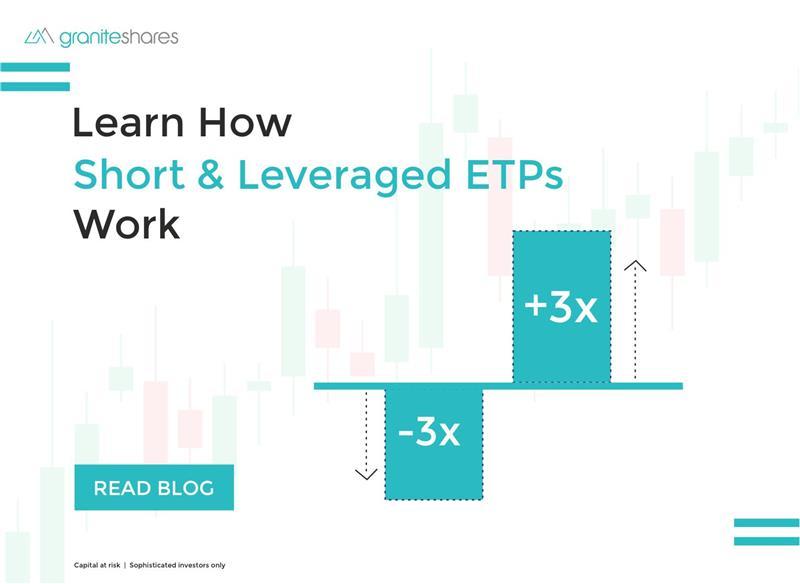How Short & Leveraged ETPs Work
Posted:
Exchange-traded products (ETPs) are a popular way for investors to gain exposure to various asset classes, such as stocks, bonds, commodities, and currencies. Within the ETP universe, there are two types of products that have gained increasing attention in recent years: short and leveraged ETPs. These products offer the potential for higher returns but come with higher risks.
Here are Five Things to know about short and leveraged ETPs:
- Short or Inverse ETPs: These products aim to provide inverse returns to a benchmark index. In other words, if the benchmark index falls by 1%, the short ETP should gain 1%. The idea behind short ETPs is to allow investors to profit from a declining market or hedge against a market downturn. However, short ETPs can be challenging to use effectively because they only provide inverse returns on a daily basis, and returns can differ significantly over longer periods. For example, Graniteshares -3x Short Tesla ETP that tracks the performance of Tesla stock. Read more on Short or Inverse ETPs by reading ‘What is Short Selling’.
- Leveraged ETPs: These products aim to provide amplified returns to a benchmark index, typically by two or three times the daily return of the index. For example, if the benchmark index rises by 1%, the leveraged ETP may gain 2% or 3%. Leveraged ETPs can provide a way for investors to amplify their exposure to a market that they believe will rise. For example, Graniteshares +3x Leverage Tesla (TSLA) ETP tracks the performance of Tesla shares. However, they can also amplify losses if the market falls. Moreover, leveraged ETPs tend to suffer from compounding effects, which can lead to underperformance over time.
- Daily resets: Both short and leveraged ETPs typically reset their exposure daily, which means that they are designed to provide their stated returns on a daily basis. However, this means that their returns over longer periods can differ significantly from what investors might expect. For example, a leveraged ETP that tracks an index that falls by 10% one day and rises by 10% the next day would lose money over the two-day period due to the compounding effects of the leverage.
- Compounding Effect: The compounding effect can have a significant impact on the performance of exchange-traded products (ETPs), especially those that track an index or a basket of assets. When an ETP reinvests its returns, the gains from the reinvested returns can generate additional returns in the future, creating a compounding effect. For example, let's say you invest in an ETP that tracks the Tesla Stock and has an annual return of 10%. If you reinvest the returns each year, your investment will grow at a compounded rate, resulting in a higher return than if you had just invested the initial amount. However, the compounding effect can also work against you if the ETP experiences losses. If the ETP has a negative return, the losses will compound over time, resulting in a greater reduction in the value of your investment. The magnitude of daily compounding will depend upon the duration of the holding of the ETP, the volatility of the security, as well as the amount of leverage used.
- Use of Trading Strategies
- Buy and Hold Strategy: This is a long-term investment strategy where an investor buys an ETP and holds it for an extended period, hoping to benefit from the potential growth of the underlying assets over time. This strategy is typically used for index-tracking ETPs.
- Tactical Asset Allocation: This is a strategy where an investor shifts their asset allocation based on market conditions. For example, if an investor believes that the stock market will decline, they may shift their investment from an equity ETP to a fixed-income ETP to reduce risk.
- Sector Rotation: This is a strategy where an investor rotates their investment between different sectors or industries to potentially benefit from the outperformance of certain sectors or industries at different times. For example, an investor may invest in an ETP that tracks the technology sector when they believe that technology stocks are poised for growth.
- Pair Trading: This is a strategy where an investor simultaneously buys one ETP and sells another related ETP. For example, an investor may buy an ETP that tracks the Tesla stock and short-sell an ETP that tracks the Tesla ETPs to potentially profit from the difference in performance between the two indices.
- Income Generation: This is a strategy where an investor invests in ETPs that provide a steady income stream, such as bond ETPs or dividend-paying equity ETPs. This strategy is typically used by investors who are looking for regular income from their investments.
Benefits of Short ETPs
Short ETPs offer a way for investors to profit from a declining market or hedge against a market downturn. Here are some potential benefits of short ETPs:
- Diversification: Short ETPs can provide investors with an additional tool for diversifying their portfolios. When traditional long investments decline, short ETPs can potentially rise and offset some of those losses.
- Hedging: Short ETPs can be used to hedge against a decline in a specific market or asset. For example, an investor who holds a long position in a particular stock or index may use a short ETP to offset potential losses in the event of a market downturn.
- Flexibility: Short ETPs can be used in a variety of market conditions, including bear markets, downturns, and corrections. Investors who use short ETPs can potentially profit in both rising and falling markets.
- Leverage: Short ETPs can provide investors with leverage, which amplifies the potential returns of an investment. By using a short ETP, investors can magnify their returns if they correctly predict a market downturn or decline.
- Liquidity: Short ETPs are traded on exchanges, providing investors with the ability to enter or exit a position quickly and easily. This liquidity can be particularly important during volatile market conditions when investors may need to quickly adjust their portfolio holdings.
Benefits of Leveraged ETPs
Leveraged exchange-traded products (ETPs) offer a way for investors to amplify their exposure to a market or asset class, potentially leading to higher returns. Here are some potential benefits of leveraged ETPs:
- Magnified returns: Leveraged ETPs aim to provide amplified returns, typically by two or three times the daily return of the underlying index or asset. This means that investors can potentially earn higher returns than they would from traditional investments.
- Diversification: Leveraged ETPs can provide investors with an additional tool for diversifying their portfolios. By gaining exposure to a variety of asset classes, investors can potentially reduce their overall portfolio risk. Investors can invest in indexes or single-stock ETPs based on various market trends to capitalize on the market trends. Read about the ‘How to Short Tesla’ blog for different ways to short a stock and more details about ETPs.
- Flexibility: Leveraged ETPs can be used in a variety of market conditions, including bull markets, upswings, and rallies. Investors who use leveraged ETPs can potentially profit in rising markets.
- Risk management: Leveraged ETPs can be used for risk management purposes, particularly in portfolios that have exposure to a specific market or asset. For example, an investor who holds a long position in a particular stock or index may use a leveraged ETP to amplify potential gains in the event of a market upswing.
- Liquidity: Leveraged ETPs are traded on exchanges, providing investors with the ability to enter or exit a position quickly and easily. This liquidity can be particularly important during volatile market conditions when investors may need to quickly adjust their portfolio holdings.
Final Thoughts:
In conclusion, short and leveraged ETPs can be powerful tools for investors who want to gain exposure to markets in a more targeted and amplified way. However, they come with higher risks and costs than traditional ETPs and are not suitable for all investors. As with any investment, investors should carefully consider their investment objectives, risk tolerance, and the potential risks and costs involved before investing in short and leveraged ETPs.
Trade Your Stocks at GraniteShares
Now that you understand the safest ways to short Tesla stock, it’s time to choose a company that provides innovative investment solutions. At GraniteShares, we provide affordable consultations about ETP strategies to help you maximize your gains while minimizing your losses.
Notable ETP strategies that we use include:
- Short Selling
- Dollar-Cost Averaging
- Asset Allocation
- Swing Trading
- Sector Rotation
- Hedging
- Learning to bet on seasonal trends
With these strategies, regardless if you’re an expert trader or just beginning, we could help you find the investment portfolio with a wide variety of assets. Trading with GraniteShares is the best step you can take towards gaining financial freedom.
Contact us today for more information about investment options and how you can start generating additional income today.
|
Product name |
Ticker(USD) |
Ticker(EUR) |
Ticker(GBX) |
|---|---|---|---|
|
GraniteShares 3x Short Tesla Daily ETP |
3STS | 3STE | 3STP |
|
GraniteShares 3x Long Tesla Daily ETP |
3LTS | 3LTE | 3LTP |
|
GraniteShares 3x Short FATANG Daily ETP |
3SFT | 3S3E | 3S3P |
|
GraniteShares 3x Long FATANG Daily ETP |
3SFT | 3S3E | 3S3P |
|
GraniteShares FATANG ETP |
FTNG | FTNE | FTNP |
|
GraniteShares 1x Short FATANG Daily ETP |
SFTG | SFTE | SFTP |
DISCLAIMER
This is a disclaimer stating that all trading and investing comes with risks. Always do your research and do not invest more than you can afford to spend.
GraniteShares accepts no responsibility for any loss or damage resulting directly or indirectly from the use of this blog or the contents. GraniteShares Limited (“GraniteShares”) (FRN: 798443) is an appointed representative of Messels Limited which is authorised and regulated by the Financial Conduct Authority.
This blog does not constitute an offer to buy or sell or a solicitation of an offer to buy securities in any company. Nothing contained herein constitutes investment, legal, tax or other advice nor is to be relied upon in making an investment or other decision. No recommendation is made positive or otherwise, regarding individual securities or investments mentioned herein. Any summary list of risk factors does not purport to be a complete enumeration or explanation of the risks involved in a particular investment. Prospective clients must consult with their own legal, tax and financial advisers before deciding to invest. This email contains the opinions of the author and such opinions are subject to change without notice. The source of data is GraniteShares unless otherwise stated. No guarantee is made to the accuracy of the information provided which has been obtained from sources believed to be reliable. This email and the information contained herein is intended only for the use of persons (or entities they represent) to whom it has been provided. Past performance is not a reliable indicator of future results. The value of an investment may go down as well as up and can result in losses, up to and including a total loss of the amount initially invested. Investments may involve numerous risks including, among others, company risks, general market risks, credit risks, foreign exchange risks, interest rate risks, geopolitical risks and liquidity risks. Please note that GraniteShares short and leveraged Exchange Traded Products are for sophisticated investors.


